30 June 2021
Dr Cate Williams: IBERS, Aberystwyth University.
- The Welsh landscape has been cared for and shaped by generations of farmers and their livestock, providing public goods and contributing to the supply chain along the way.
- Pasture, and in particular rough grazing, produces meat with a health beneficial fatty acid profile containing enhanced levels of polyunsaturated fats, conjugated linoleic acid, omega-3s and cholesterol-neutral saturated fats.
- The effect of this fat profile on taste is debated, with some finding it results in a darker, more tender meat, with a stronger taste and others reporting a tougher texture and an unpleasant flavour.
- Carefully managed and non-intensively grazed upland flocks have the potential to support ecosystems, biodiversity and help to manage the iconic landscape.
A wealth of research supports the differences between concentrate-fed and grass-fed meat from both sheep and cattle – in both composition and sensory qualities. Studies consistently show that grass-fed lamb contains higher levels of human health-beneficial fatty acids (such as conjugated linoleic acid and omega-3 fats) and a bias towards C18:0 (stearic acid) in terms of the saturated fat profile. The perception of the eating qualities of grass-fed meat is more contentious, with subjective assessments sometimes finding a less favourable taste and/or smell. On the other hand, when the lipid profile is dominated by polyunsaturated fats (PUFA) this lowers the melting point of the fat and makes for superior eating quality. Some evidence suggests that animals grazed on rough/natural grazing produce meat with a higher vitamin E content which may extend the shelf life of the end-product, but variable time frames are given for the effects of grazing to become apparent.
Understanding fatty acids
Lipids (or fats) are an essential part of human nutrition, providing energy, regulating hormones and acting as transport for several vital vitamins and other fat-soluble nutrients. Fats may be categorised into saturated (SFA) or unsaturated (UFA) which refers to how many carbon double bonds the molecule has and consequently how many hydrogen atoms are attached. UFA may be further split into monounsaturated fats (MUFA) which have one double bond (and are missing 2 hydrogen atoms) and PUFA which have more than one double bond and are missing more than 2 hydrogen atoms. SFAs are widely regarded as detrimental to human health, although some more so than others. Meanwhile, MUFA and PUFA are beneficial and contribute to many important aspects of human health, such as brain and nerve function, protection against cardiovascular disease and as anti-inflammatory agents. Lipids can be named and described in many different ways, some of the common ones in ruminant meat include:
C18:0 (stearic acid) – a saturated fat that is not detrimental to human health and contributes to normal cholesterol levels.
C16:0 (palmitic acid) –the most abundant SFA in ruminant meat that is detrimental to human health and often involved in cardiovascular diseases.
C18:3 (n-3) (omega-3 or linolenic acid) – A health beneficial PUFA that acts as an anti-inflammatory and can reduce the risk of strokes.
C18:2 (n-6) (omega-6 or linoleic acid) - A health beneficial PUFA that supports heart health, reduces bad cholesterol levels and reduces the risk of coronary heart disease.
Composition
Many factors influence the qualities of lamb and may be divided into internal effects (breed, sex etc.) and external (diet, rearing system, climate etc.). Falling into the latter category, the diet plays a pivotal role in determining the qualities of the meat and milk produced. That said, internal and external factors are closely intertwined, and it's often challenging to separate them. A good example of this is found in a study comparing lamb from different breeds as well as different production systems. Upland grazed Welsh mountain sheep, lowland grazed Soays and two groups of Suffolks one on grass and another fed concentrates were compared. The two Suffolk groups had heavier, better-muscled carcasses whilst the Soay and Welsh Mountain sheep were much leaner - a result of breed rather than management. However, regardless of breed, all grazed lamb had higher concentrations of omega-3 PUFAs whilst concentrate-fed lambs produced meat containing more omega-6 PUFA. Suffolk lambs scored poorly in taste tests whilst Welsh Mountain and Soay lamb scored higher, demonstrating another breed effect. It is important to consider interactions between environmental factors and genetics so that traits can be correctly attributed but also so that the best breed is combined with the most appropriate production system.
Perhaps the most easily manipulated fraction of red meat is the lipid profile, which also contributes to eating and nutritional quality. Studies have found that grass-fed lamb has enhanced levels of human health beneficial conjugated linoleic acid (CLA), CLA precursors and omega-3 and omega-6 fatty acids in addition to a higher level of cholesterol neutral saturated fat (stearic acid). On the other hand, grass-fed lamb contains lower levels of palmitic acid which is detrimental to human health, with links to cardiovascular disease and some cancers.
Looking at the quality of meat from lambs grazed on unimproved, rough mountainous pastures (1,000 M above sea level) versus with those on improved, lowland grazing, significant differences were recorded in fat content and composition, meat colour and flavour. Mountain-grazed lamb had lower levels of fat in general (an average difference of -20%) and fat profiles contained higher levels of PUFA (+32%) but a lower level of monounsaturated fats (MUFA; by -5%). The protein content of mountain lamb was also higher by an average of +2%. Taste panels found few differences between the two grazing systems, but notable findings included mountain-grazed meat tasting more tender and less greasy.
A study comparing grass-fed British lamb with concentrate-fed Spanish lamb also found notable differences in fatty acid profile as a result of diet. Grass-fed lamb had higher percentages of cholesterol-neutral stearic acid and several omega-3 fatty acids but lower levels of omega-6 fats than concentrate-fed lambs. Odour and flavour intensity was stronger in grass-fed lambs than those fed on concentrates, resulting in the grass-fed lamb scoring higher for flavour quality and overall appraisal than concentrate-fed lamb.
Looking at differences between housed and grazed lambs, once again, meat from grazed lambs had a more favourable fatty acid profile with lower proportions of SFA (-12%) and higher levels of PUFA (+33%), though less MUFA (-9%). The ratio of omega 3: omega 6 FAs was also better in grazed lamb, all of which comes together to give a more health beneficial fatty acid profile.
Eating qualities
The composition of grass-fed meat, especially those on rough pastures, appears superior to that fed on concentrates, however, reported differences in flavour, colour and texture are inconsistent.
In general, grass-fed meat is darker, this is thought to be due to levels of physical activity as the animal forages but may also be influenced by age of the animal, feeding before slaughter and storage conditions. Diet also affects meat tenderness, with some reports suggesting that a roughage-based diet results in tougher meat, although comparisons between forage- and concentrate-based diets are mixed.
The lipid profile and fat levels of meat contribute significantly to flavour by various means and determine the type of compounds produced during cooking where lipids can act as a carrier for other compounds. When meat is rich in PUFA, this may detract from the overall flavour, as these fats are sensitive to oxidation at low temperatures, which lead to colour changes and unpleasant flavours. However, PUFA and MUFA also have a much lower melting point than SFAs which can contribute to superior eating quality. Their melting point is significantly lower overall than that of SFAs due to their double and triple bonds (Figure 1). Double and triple bonds cause the molecule to kink meaning that they cannot sit as close to one another, whereas SFAs have a straighter structure and can sit closer, forming stronger forces (Figure 1). A lower fat melting point is considered desirable in terms of eating quality as the fat melts and does not produce a “film” in the mouth.
Figure 1: The molecular structure of an unsaturated and saturated fat showing proximity and formation of intramolecular forces and hydrogen bonds.
Environmental and cultural importance
The biggest advantage of ruminal fermentation is the animal’s ability to turn low-quality forage into high quality, nutritionally dense meat and milk. Sometimes considered a traditional approach to farming, the use of uplands for grazing capitalises on this natural ability whilst also contributing to sustainability and public goods. Sheep are well suited to the uplands being of a smaller body size they cause less ground damage as well as being hardy with good foraging instincts.
Studies have found that the carbon (C) storage potential of uplands under low-intensity grazing is comparable to land that is not grazed at all. Under both management systems, C sequestration was enhanced compared to a commercial/intense grazing situation. Upon the removal of grazing, some species will flourish (e.g. bracken) whilst others thrive when grazed (e.g. deergrass or mat-grass). But, it is predicted that in the short term species diversity will increase with grazing – especially acid grasslands – although this hinges on plant community composition. Several studies advocate the use of mixed grazing, as cattle and sheep complement one another in terms of foraging strategies and under the correct management can benefit biodiversity whilst maintaining good production levels.
Many aspects of the Welsh landscape owe their existence to generations of farmers and their animals who manage and maintain the land, attracting tourists and contributing to a strong culture and sense of patriotism. Of course, hill and upland systems also play a key role in food networks and supply chains, helping to feed the nation.
Summary
The uplands are a staple feature of the Welsh landscape, managed by generations of farmers as a public good, they attract tourists, maintain habitats and biodiversity and contribute a sense of culture. Farming livestock on these lands also contributes high-quality meat to the food chain as the differences between grass-fed and concentrate-fed lamb are stark and grazing on rough pastures also produces unique benefits. Studies consistently show that grazing results in a more human health beneficial lipid profile – rich in PUFA and omega-3 fats and with a higher proportion of cholesterol-neutral SFAs. Grazing lambs on rough or mountainous pastures has been observed to enhance these qualities further and sometimes boost the vitamin E and antioxidant content of meat which could contribute to longer shelf life. Those reared on pastures tend to produce darker meat with a stronger taste and lower levels of fat overall though opinions on tenderness are mixed. Whilst fat profiles containing high levels of PUFA are sensitive to oxidation and may result in unpleasant flavours, it is also reported that due to their structure, these fats result in a lower fat melting point which enhances eating quality. Further research on the sensory properties of upland lamb, particularly in the eyes of the British consumer, would be highly beneficial and could help pave the way for marketing upland lamb at a premium level.



